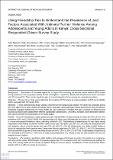| dc.contributor.author | Memiahe, Peter | |
| dc.contributor.author | Kamau, Anne | |
| dc.contributor.author | Opanga, Yvonne | |
| dc.contributor.author | Muhula, Samuel | |
| dc.contributor.author | Nyakeriga, Emmanuel | |
| dc.contributor.author | Humwa, Felix | |
| dc.date.accessioned | 2021-09-10T21:54:49Z | |
| dc.date.available | 2021-09-10T21:54:49Z | |
| dc.date.issued | 12/31/2020 | |
| dc.identifier.citation | Memiah P, Kamau A, Opanga Y, Muhula S, Nyakeriga E, Humwa F, Cook C, Kingori C, Muriithi J Using Friendship Ties to Understand the Prevalence of, and Factors Associated With, Intimate Partner Violence Among Adolescents and Young Adults in Kenya: Cross-Sectional, Respondent-Driven Survey Study Interact J Med Res 2020;9(4):e19023 | en_US |
| dc.identifier.other | doi: 10.2196/19023 | |
| dc.identifier.other | PMID: 33382380 | |
| dc.identifier.other | PMCID: 7808892 | |
| dc.identifier.uri | http://repository.amref.org/handle/123456789/243 | |
| dc.description | Copyright
©Peter Memiah, Anne Kamau, Yvonne Opanga, Samuel Muhula, Emmanuel Nyakeriga, Felix Humwa, Courtney Cook, Caroline Kingori, Job Muriithi. Originally published in the Interactive Journal of Medical Research (http://www.i-jmr.org/), 31.12.2020.
This is an open-access article distributed under the terms of the Creative Commons Attribution License (https://creativecommons.org/licenses/by/4.0/), which permits unrestricted use, distribution, and reproduction in any medium, provided the original work, first published in the Interactive Journal of Medical Research, is properly cited. The complete bibliographic information, a link to the original publication on http://www.i-jmr.org/, as well as this copyright and license information must be included. | en_US |
| dc.description.abstract | Background: Optimization of innovative approaches is required for estimating the intimate partner violence (IPV) burden
among adolescents and young adults (AYA). Further investigation is required to identify risk and protective factors associated
with IPV among AYA. There remain significant gaps in understanding these factors among this vulnerable population.
Objective: The goal of our study was to determine the prevalence of IPV among an urban population of AYA and to identify
factors associated with IPV among AYA.
Methods: A cross-sectional study design utilizing respondent-driven sampling was adopted. The study was conducted among
887 AYA, aged 15 to 24 years, residing in Nairobi, Kenya. Data were collected through a phone-based survey using the REACH
(Reaching, Engaging Adolescents and Young Adults for Care Continuum in Health)-AYA app. Questions on behavioral and
psychosocial factors were adopted from different standardized questionnaires. Descriptive, bivariate, and multivariable statistics
were used to describe the characteristics of the study sample.
Results: Of the 887 participants, a higher proportion were male (540/887, 60.9%) compared to female (347/887, 39.1%). The
prevalence of IPV was 22.3% (124/556). IPV was associated with being unsure if it was okay for a boy to hit his girlfriend, living
in a home with physical violence or abuse, and being bullied (P=.005). The likelihood of experiencing IPV was higher among
respondents whose friends and family members used alcohol (odds ratio [OR] 1.80, 95% CI 1.09-2.98) and among those who
had repeated a class at school in the past two years (OR 1.90, 95% CI 1.11-3.23). Respondents who visited a health facility or
doctor for reproductive health services were 2 times more likely to experience IPV (OR 2.23, 95% CI 1.40-3.70). Respondents
who had used illicit drugs were 2 times more likely to experience IPV (OR 4.31, 95% CI 2.64-7.04). The probability of experiencing
IPV decreased by 63% (OR 0.37, 95% CI 0.16-0.85) among respondents who refused to have sex with someone who was not
prepared to use a condom.
Conclusions: IPV remains a significant public health priority because of its impact to society. Our results are in congruence
with other similar studies. Efforts toward incorporating appropriate IPV core measures into the comprehensive care package for
every AYA seeking health services should be explored. Programs need to address constellations of risk and protective factors
linked to IPV in an effort to prevent its occurrence. | en_US |
| dc.description.sponsorship | k CODESRIA (Council for the Development of
Social Science Research in Africa) , and HIV Intervention Science Training Program
(HISTP), a National Institute of Mental Health–funded multidisciplinary training program (No. R25MH080665) | en_US |
| dc.language.iso | en | en_US |
| dc.publisher | JMIR Publications | en_US |
| dc.subject | Intimate partner violence | en_US |
| dc.subject | Adolescents | en_US |
| dc.subject | Young adults | en_US |
| dc.subject | Bullying | en_US |
| dc.subject | Physical abuse | en_US |
| dc.subject | Abuse | en_US |
| dc.subject | Africa | en_US |
| dc.subject | Prevalence | en_US |
| dc.subject | Risk | en_US |
| dc.title | Using Friendship Ties to Understand the Prevalence of, and Factors Associated With, Intimate Partner Violence Among Adolescents and Young Adults in Kenya: Cross-Sectional, Respondent-Driven Survey Study | en_US |
| dc.type | Article, Journal | en_US |

